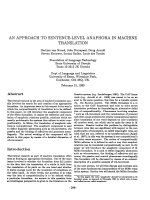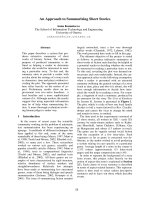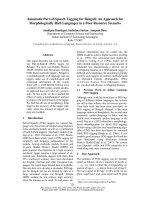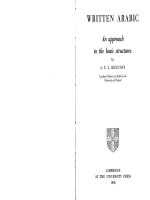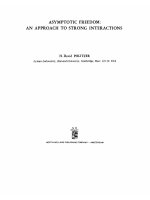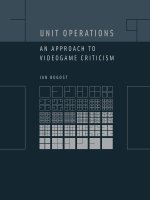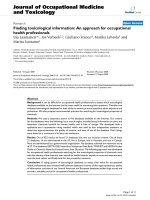Teaching children road safety through storybooks: An approach to child health literacy in Pakistan
Bạn đang xem bản rút gọn của tài liệu. Xem và tải ngay bản đầy đủ của tài liệu tại đây (582.02 KB, 8 trang )
Ahmad et al. BMC Pediatrics (2018) 18:31
DOI 10.1186/s12887-018-0982-5
RESEARCH ARTICLE
Open Access
Teaching children road safety through
storybooks: an approach to child health
literacy in Pakistan
Haris Ahmad, Rubaba Naeem, Asher Feroze, Nukhba Zia, Amarah Shakoor, Uzma Rahim Khan
and Asad Iqbal Mian*
Abstract
Background: Road traffic injuries (RTIs) commonly affect the younger population in low- and-middle-income
countries. School children may be educated about road safety using storybooks with colorful pictures, which
tends to increase the child’s interest in the text. Therefore, this study assessed the use of bilingual pictorial
storybooks to improve RTI prevention knowledge among school children.
Methods: This pretest-posttest study was conducted in eight public and nine private schools of Karachi,
Pakistan, between February to May 2015. Children in grades four and five were enrolled at baseline
(n = 410). The intervention was an interactive discussion about RTI prevention using a bilingual (Urdu and
English) pictorial storybook. A baseline test was conducted to assess children’s pre-existing knowledge
about RTI prevention followed by administration of the intervention. Two posttests were conducted: first
immediately after the intervention, and second after 2 months. Test scores were analyzed using McNemar
test and paired sample t-test.
Results: There were 57% girls and 55% public school students; age range 8–16 years. Compared to the overall
baseline score (5.1 ± 1.4), the number of correct answers increased in both subsequent tests (5.9 ± 1.2 and 6.1 ± 1.1
respectively, p-value < 0.001). Statistically significant improvement in mean scores was observed based on gender,
grades and school type over time (p-value < 0.001).
Conclusion: Discussions using bilingual pictorial storybooks helped primary school children in Pakistan grasp
knowledge of RTI prevention. RTI education sessions may be incorporated into school curricula using storybooks as
teaching tools. Potential exists to create similar models for other developing countries by translating the storybooks
into local languages.
Keywords: Road traffic injury, Education, Lower- and-middle-income countries, Children, Bilingual books, Pakistan
Background
Each year, greater than 1.2 million people die globally
due to road traffic injuries (RTIs) and 90% of these occur
in low-and-middle-income countries (LMICs) [1]. This
frequently affects people between 4 and 55 years of age
[1, 2]. In 2015, RTIs were responsible for 24% of injuryrelated deaths among the 0–19 year age group [3]. The
road traffic fatality rate in the Eastern Mediterranean region (EMR) and South-East Asia in 2015 was 19.9 and
17 per 100,000 population respectively, as compared to
* Correspondence:
Aga Khan University Hospital, Karachi, Pakistan
9.3 in Europe [1]. Pakistan, located in the EMR, has a
young population; about 16% of estimated RTI deaths in
Pakistan occur in children between 1 and 19 years of age
[3]. An emergency department-based surveillance study
conducted in 2007 at selected sites of five LMICs,
including Pakistan, found that RTIs were the second
leading cause of injuries among children ages 0–12
[4]. In 2013, RTI was found to be responsible for 12%
of the under 5 injury mortality rate in Pakistan [5].
Children often play or wander unsupervised on
streets and are vulnerable to RTIs, especially in
LMICs such as Pakistan [6, 7].
© The Author(s). 2018 Open Access This article is distributed under the terms of the Creative Commons Attribution 4.0
International License ( which permits unrestricted use, distribution, and
reproduction in any medium, provided you give appropriate credit to the original author(s) and the source, provide a link to
the Creative Commons license, and indicate if changes were made. The Creative Commons Public Domain Dedication waiver
( applies to the data made available in this article, unless otherwise stated.
Ahmad et al. BMC Pediatrics (2018) 18:31
Private and public schooling in Pakistan is variable
due to different school systems and curricula, which
likely causes inconsistencies in the education that
children receive [8–10]. Regardless of school type – private or public – their curricula generally do not incorporate child-centric instruction about health concerns
such as RTI and its prevention among children. Reading
material with simple text and contextual illustrations are
likely to attract children’s interest; innovative interventions, such as those featuring children reading developmentally appropriate books (which have colorful
pictures and humorous language), have been shown in
past studies to increase children’s vocabulary [11]. There
is strong evidence supporting the idea that the presence
of colorful pictures increases a child’s interest in the text
[12]. Furthermore, past literature has shown that educational interventions help to increase knowledge of traffic
safety among both students and their parents [13]. Injury
prevention is important to reduce the growing burden of
RTIs and fatalities [6, 14]. It is important that preventive
education be given to children in addition to their regular education.
This study focused on a paradigmatic shift to raise
awareness about child RTI prevention. We aimed to assess whether RTI prevention education through bilingual
pictorial storybooks improved RTI prevention knowledge in primary school children — with particular focus
on pedestrian, car, and bicycle injuries — by comparing
the changes in knowledge among children in two different grades, and the attendance of private versus public
school systems in Karachi, Pakistan.
Methods
Study design
This was a child education-based pretest-posttest intervention study [15].
Study population
Children in grades four and five.
Study setting
The Executive District Officer of Education (EDO of
Education) of the Karachi district provided a list of registered public and private schools of Karachi [16]. Based
on the list there are an estimated 3075 public schools
and 7000 private schools in Karachi. The schools and
grades were conveniently selected from the EDO list on
the basis of rapport developed with these schools during
past research interactions. In total, seventeen schools
were enrolled in the study, eight public and nine private.
Permission to conduct the study in public schools was
obtained from the EDO. The school administration,
head teacher or assistant principal (including head principals) were approached via phone calls and personal
Page 2 of 8
visits for permission to include their students in the
study. The schools were continuously added to the study
until the minimum sample size was reached. All schools
approached agreed to participate in the study. The selection of schools, although purposive was from a large
catchment area of Karachi, and therefore the sample was
fairly representative and likely free of major bias.
Duration
The study was conducted from February to May 2015.
Sample size
Since there are no estimates available related to children’s knowledge about RTI prevention, sample size was
calculated assuming 50% baseline knowledge of RTI in
children from grades four and five, and a conservative
increase in knowledge of 10% after the intervention. This
10% change in knowledge from baseline to postassessment was used for sample size calculation. Thus,
the minimum sample size of 400 students was calculated
at α = 5% and power of 0.8.
Intervention
The intervention comprised of an interactive discussion
about RTI prevention using a bilingual pictorial storybook called Biloongra which is already in the market and
is published by Bookgroup, a child literacy research
organization whose books are part of curricula in many
Pakistani schools [17]. The senior author of this paper
(AIM) was involved with Bookgroup to develop the
Biloongra series. Biloongra in Urdu, the main language
of Pakistan, means kitten, but more commonly is used
as a term of endearment for a child. The target age
range for the Biloongra books is 8–12 years, per the
book developers. The stories revolve around a family of
two siblings, their parents and their pet kitten. The particular story book from the series that we chose for the
intervention (Fig. 1) was relevant to the study because
the story’s plot involves children playing outside the
house in their neighborhood — thus, suitable to delve
into RTI prevention. The injury expert in our group
(URK) chose this book after reading all books in the
series. The books are bilingual, in Urdu and English, as
both languages are used as media of instruction in Pakistani schools. It was distributed to all children and then
read to them either in Urdu or English—based on what
was more suitable for each child—by a trained research
assistant, with a discussion incorporated into the reading
session. Subtle themes in the book related to playing
outside on the streets and the associated risk of RTI and
prevention among children were highlighted during the
discussion, with particular focus on pedestrian, car, and
bicycle injuries. Children were prompted to present their
opinions about RTI prevention for characters in the
Ahmad et al. BMC Pediatrics (2018) 18:31
Page 3 of 8
questionnaire. The questions in the data collection tool
were explained to children by the research assistant.
Pilot testing of intervention and questionnaire
The intervention and data collection tool were piloted at
a school, in order to assess feasibility of administration
as well as to determine time required for said intervention. The findings from the pilot were used to improve
both the intervention and the questions in the data
collection tool of the main study.
Data collection procedure
Fig. 1 Cover of storybook used as educational intervention for the
study (JPEG used with permission from the publisher)
storybook. The primary language of discussion was Urdu,
as most children understood Urdu better than English.
For demonstration purposes, a poster (see Additional file
1) depicting aspects of road safety (traffic lights, zebra
crossing, etc.) was used. An interactive discussion of approximately 1 h in each classroom, including questionnaire administration, was conducted during school hours.
Data collection tool
The data collection tool was a bilingual (English and
Urdu) multiple choice questionnaire (see Additional file
2). It was originally developed in English and then translated into Urdu. The knowledge assessment questionnaire was developed by the injury prevention expert in
our group (URK) after accessing several previous studies.
Another injury prevention expert (Dr. Junaid Bhatti)
reviewed the whole questionnaire and provided feedback
for improvement. Each question was checked for relevance prior to inclusion in the tool. The tool had a total
of 10 questions on basic road safety (with multiple
choice of three responses). The questions were intended
to gauge knowledge of children regarding various aspects of road safety including playing outside on streets,
their eagerness to receive RTI prevention education, and
their opinion on whether storybooks help them in
retaining information. The questionnaire was also meant
to gauge their knowledge regarding pedestrian and bicycle safety and adherence to traffic rules. Information
related to age, gender, grade, and type of school was also
collected at baseline. Only one answer choice out of the
three given choices was correct for each of the first
seven questions; the remaining three questions were
opinion-based with no right or wrong answers. A child
could therefore get a maximum score of seven in the
During visits to schools, baseline data on students’
demographics and their knowledge about road safety
was collected. This was followed by administration of
the intervention. There were two posttests conducted;
first immediately after the intervention and the second
about 2 month post-intervention. Overall, the children
were administered the same tool for the three assessments (baseline, posttests I and II). The second posttest
was conducted to gauge level of children’s retention of
information from the intervention. Absentees in the first
posttest were subsequently excluded from the second
posttest.
Data analysis
Data entry was done in EpiData version 3.1 [18] by two
different operators and dual errors were then cleaned
and updated in the final data set. Data was analyzed
using SPSS version 20 [19]. Proportions of correct answers for each question were compared against each
test. Since the data obtained was paired with a binary
outcome (yes/no) form, the McNemar Test was applied
[20]. The binary data was then converted into quantitative form by giving one mark to every correct response.
The score calculated by summing all seven questions
ranged from 0 to 7. A repeated measurement analysis
approach through a generalized linear model (GLM)
technique was used. A p-value of <0.05 was considered
to be statistically significant. The significant differences
in mean change scores for the baseline test and posttests
were compared using paired t-test. Results obtained
were compared based on gender, grade, and type of
school system. Since the target age range for the Biloongra books is 8–12 years, the decision to stratify analyses
by grades four and five was based on that.
Results
A total of 410 students of mean age 11.1 ± 1.4 years were
enrolled. As Table 1 shows, there were 43.2% (n = 177) boys
and 56.8% (n = 233) girls. Forty-nine percent (n = 201) of
the students were in grade four, and 51% (n = 209) in grade
five. Over 50% of the students were from public schools
(54.6%, n = 224). In posttest II, data was collected from 303
Ahmad et al. BMC Pediatrics (2018) 18:31
Page 4 of 8
Table 1 Demographic characteristics of study participants (n =
410 and n = 303)
Baseline test and posttest I
N (%); n = 410
Posttest II
N (%); n = 303
Male
177 (43.2)
129 (42.6)
Female
233 (56.8)
174 (57.4)
8–9 years
20 (4.9)
15 (5.0)
10–11 years
187 (45.6)
145 (48.0)
Gender
Age Group
12–13 years
173 (42.2)
122 (40.4)
14–16 years
30 (7.3)
20 (6.6)
Mean ± S.D. (in years)
11.1 ± 1.4
11.5 ± 1.4
Grade 4
201 (49.0)
147 (48.5)
Grade 5
209 (51.0)
156 (51.5)
Public
224 (54.6)
171 (56.4)
Private
186 (45.4)
132 (43.6)
Grades
Type of School
students. The remaining students (24% of the original sample) were either absent on the day of posttest II, or had left
the school (i.e. they had either dropped out of or changed
their school).
Repeated measurement analysis was used through
GLM method to compare the mean scores over time
(different phases). Table 2 showed a positive change in
mean scores over three different time periods (baseline,
posttest I & II) by gender, grade and school type. Boys
had a higher mean score in each test compared to girls
(p-value < 0.001). Fig. 2 shows the mean scores of both
genders over time in the three tests. Time and gender
effect was not found in mean scores of children in all
three tests (p-value 0.331).
Repeated measurement analysis showed that the mean
scores of grade five children were higher than those of
grade four in the baseline and posttest I. The posttest II
mean scores of grade five students were the same as
posttest I scores. On the other hand, the posttest II
scores of grade four students were higher than posttest I scores (p-value <0.001). Fig. 2 shows the mean
scores of both grades over time in the three tests.
Both time and grade interaction effect was found to
be significant (p-value = 0.003).
Both public and private schools displayed an increment in the mean score over time (p-value < 0.001). The
“time” and “school type” interaction was also highly significant (p-value = 0.009) which showed that the mean
scores of public school students were initially lower than
those of private schools in both the baseline (5.0 v/s 5.2)
and posttest I (5.7 v/s 6.1). However, the mean scores
were higher for public schools in posttest II (6.2 v/s 6.0).
Fig. 2 shows the mean scores of both types of schools
with time in the three tests. Both types of schools scored
higher mean scores in the two posttests compared to the
baseline scores.
In the question-by-question analysis of paired cases as
shown in Table 3, the percentage of correct answers in
the two subsequent tests consistently remained higher
than the percentage of correct answers in the baseline
data. Among the specific questions asked in the tests,
the question about using a zebra crossing to cross roads
revealed high statistical significance in the paired
comparison across all three tests (p-value < 0.001). In the
paired cases comparisons, progressively higher percentages of study participants agreed in each subsequent test
that using pictorial storybooks helped them to
Table 2 Comparison of mean scores over time by demographic factors (n = 296)*
Baseline
test
Posttest
I
Posttest
II
n
5.1 ± 1.4
5.9 ± 1.2
6.1 ± 1.1
296
< 0.001
–
Male
5.0 ± 1.3
6.0 ± 1.1
6.2 ± 1.0
126
< 0.001
0.331
Female
5.1 ± 1.5
5.8 ± 1.3
6.1 ± 1.1
170
Grade 4
4.8 ± 1.4
5.6 ± 1.3
6.1 ± 1.0
143
< 0.001
0.003
Grade 5
5.3 ± 1.4
6.1 ± 1.1
6.1 ± 1.1
153
Public
5.0 ± 1.5
5.7 ± 1.3
6.2 ± 1.1
167
< 0.001
0.009
Private
5.2 ± 1.4
6.1 ± 1.1
6.0 ± 1.0
129
Overall
Within subjects effects
P-value**
P-value***
Gender
Grades
School Type
* Reported as Mean ± SD
** Significant value < 0.05 for change over time (phases) only
*** Significant value < 0.05 for combined effect of time & different factors (school type, grade and gender)
Ahmad et al. BMC Pediatrics (2018) 18:31
Page 5 of 8
Fig. 2 Error bar plots over time by (a) gender, (b) grade, and (c) school type
remember information and they should be taught about
RTI prevention in schools. In questions 3 and 6, the percentage of correct answers declined in the second posttest when compared with the first posttest in paired
cases comparisons. This suggests that students forgot
some information in the 2 month gap since the intervention was given.
Discussion
This study is the first of its kind in Pakistan, in which bilingual pictorial storybooks have been used for road
safety information dissemination among young school
children. Both genders gained from the intervention.
While effect of the intervention was observed in both
genders, improvement was larger in grade four students
likely because of lower baseline, although the ending
score (posttest II) was about the same for both grades.
Our study also showed that both the public and private
sector school students benefitted from the use of bilingual pictorial storybooks in the generation of road safety
knowledge.
Although the impact of the intervention when compared to the baseline is high in both posttests, the study
participants tended to forget some of the messages from
the intervention with the passage of time, as mean
scores were slightly lower for a few questions in the
long-term test. Thus, the intervention appears to be effective in increasing knowledge of school children in
both the short- and long-term, but there may be a need
for regular road safety education to further ensure that
students retain traffic safety messages in the post-test II.
Reinforcing the message through refresher courses can
be a way to instill behavior change among children in
regards to road safety.
This study showed that the intervention was especially
useful in giving the students better knowledge about the
Table 3 Comparison of percentage of correct responses in the three tests – Paired Cases
Post Difference n
test I
%
Post Difference n
test II
%
Question
n
If your football rolls across the road, how
should you get your football back?
396 86.1
87.4
1.3
293 86.0
90.4
4.4
294 86.4
90.1
3.7
When walking on the road, how should you
walk?
396 84.1
94.9
10.9
297 84.5
96.6
12.1
298 94.3
96.6
2.3
What care should one take when riding a
motorcycle?
395 85.8
90.1
4.3
296 86.5
89.2
2.7
297 90.2
88.9
-1.3
When inside a moving car, what is most
unsafe to do?
393 68.4
71.2
2.8
298 67.1
85.6
18.5
294 71.4
86.1
14.6
Where is it most safe to cross a road?
396 50.8
85.4
34.6
301 51.2
92.4
41.2
295 86.8
92.5
5.8
Baseline
test
%
Baseline
test
%
Post Post Difference
test I test II
%
%
How should one ride in a car?
398 64.6
84.7
20.1
299 64.5
78.9
14.4
295 84.7
79.0
-5.8
In your opinion, how often should a driver
stop at a red signal?
394 71.1
78.2
7.1
298 72.1
80.5
8.4
294 76.2
80.6
4.4
Do you think it is safe to play on the streets
near your home without adult supervision?
396 70.2
69.9
-0.3
299 71.6
84.6
13.0
296 71.6
83.8
12.2
Do you think you should be taught about
traffic safety in school?
396 84.8
87.6
2.8
299 84.9
88.6
3.7
296 87.5
88.5
1.0
Do you think storybooks with pictures help
you remember information?
395 81.8
88.1
6.3
299 80.6
89.3
8.7
296 87.5
89.5
2.0
Bold implies that difference was statistically significant
Ahmad et al. BMC Pediatrics (2018) 18:31
benefits of using, and dangers of not using, zebra crossings. It is understandable that the baseline information
was low about zebra crossings as there is no culture of
using them in Pakistan. It demonstrated that school
children find usage of pictorial storybooks to be helpful in
retaining knowledge, and that they feel there is a need for
traffic safety information to be disseminated in schools.
As the storybooks were bilingual, it was anticipated
that private English medium school children would better appreciate the story in English, while the public Urdu
medium school children would receive the Urdu story
more readily. However, observations from this study
suggest that Urdu is the preferred medium of communication and instruction for students from both sectors, as
most students answered the bilingual questionnaire in
Urdu and preferred the bilingual story to be read aloud
in Urdu.
A limitation of this study was related to the pretestposttest study design, which does not have a control
group for comparison in data analysis. Without a control
group, it is difficult to connect the answers in posttest I
and II with the intervention only. The fact that the
children had been exposed to an evolution in baseline
could be a trigger to try to know more (or discuss with
parents, more awareness, and so on). Although this
might be a valid assumption, it is likely partially true, because the baseline test (pretest) and posttest I were done
the same day within 1 h of each other and the children
did not leave the classroom in between tests. External
factors may have played a role for posttest II, but that is
a given for pretest-posttest study designs. It is still unlikely in our context, because awareness forums for RTI
prevention for children are rare, parents are unlikely to
discuss this with their children as a major health issue,
and lack of adherence to traffic laws hinder natural evolution of said awareness.
Another limitation was that activities carried out by
the research team were at times conducted during extracurricular activity time in schools. This resulted in a
variation in duration of activities ranging from 5 to
15 min (sessions in some schools were briefer than in
others due to time constraints). At times, the attention
of school children wavered from the discussion when
they were kept in class during break time for the session
while their friends from other classes were playing outside. The attention of children was refocused by promising recreation time and snacks after the data collection.
There was often a need to explain the questions in the
data collection tool to students. Effort was made to
reduce undue variations by training the research assistant, who then single-handedly introduced interventions
in all schools.
One further limitation was that the children had a tendency to occasionally speak the answers aloud, or to
Page 6 of 8
peek into each other’s papers, or to whisper answers to
their neighbours. Efforts were made to minimize this
cross-communication in the classrooms while the questionnaires were being administered, but given the small
classroom sizes and cramped seating spaces, crosscommunication remained inevitable. A poster depicting
aspects of road safety was used from time to time. Effort
was made to rely on the storybooks and not on the poster so as to determine the usefulness of the storybooks
in instructing children about RTI prevention. Additionally, a number of students from the original study sample were absent in phase II of data collection. By the
time phase II of the data collection was carried out, the
students had graduated from grades four and five (the
original and intended study sample in phase I) to grades
five and six, respectively.
The age range of final study participants was 8–
16 years, which although wide for grades four and five,
the intellectual capabilities of those students was likely
quite similar. It is important to keep in mind that the
target age range for these books is 8–12 years, and
therefore they are not entirely pictorial; there is text that
is supported by illustrations. We wanted to have comparable intellectual capabilities of children to understand
the book and questionnaire; hence, grades four and five
were taken even though there was variation in their ages.
It would have been impractical to select same age children from different grades and sections – not only
would that have required a lot more effort, it would also
have disrupted classes, so we decided to work with all of
the children in grades four and five.
This study cannot demonstrate true practices regarding road safety being followed by the enrolled school
children. Hence, it is not known whether the road safety
information disseminated during the intervention had an
impact on daily life application of these safety practices
among the school children. It is noteworthy that previous studies and behavior theories consider behavior
change based on imparting knowledge alone to be an
unrealistic expectation, especially if such knowledge dissemination is not accompanied by complementary structural changes [21, 22].
The findings of this study are in line with a past study
by Bachman et al. [13] which showed that educational
interventions helped to increase knowledge about traffic
safety among students. Our findings are also consistent
with earlier studies that found that curricula addressing
injury prevention increases school children’s knowledge
[21, 23, 24].
A possible benefit of the intervention, which has not
been validated in this study but indicated in previous literature, is the spill-over effect of children imparting the
knowledge they have received to others, including their
parents, which leads to safety improvements [21].
Ahmad et al. BMC Pediatrics (2018) 18:31
While this study showed that the intervention through
bilingual pictorial storybooks resulted in significant
change in road safety knowledge of young school children, a large-scale trial is required to assess effectiveness
of the intervention and to gauge which group gains most
benefit from it. This may be through a randomized trial
comparing traditional teaching versus one that utilizes
storybooks, as done in our intervention.
Page 7 of 8
and drafting the manuscript. AF checked, cleaned, and performed all statistical
analyses of the data; developed all tables and graphs; and provided technical
input in the data interpretation. NZ contributed in training the research assistant
in data collection and translating the data collection instrument, piloting the
study, data interpretation, and critically reviewing the manuscript as submitted. AS
helped in conceptualization of the study. URK helped in conceptualization of the
study, devising methodology, developing the tool for the study, training the
research assistant in data collection and translating the data collection instrument,
piloting the study, supervising data collection, data analysis input, and critically
reviewing the manuscript as submitted. AIM conceptualized the study, arranged
for books from the Bookgroup, contributed in training the research assistant for
data collection and in translating the data collection instrument, and critically
reviewed the manuscript as submitted. All authors approved the final manuscript
as submitted and agree to be accountable for all aspects of the work.
Conclusion
Road Traffic Injuries (RTI) are a serious cause of morbidity
and mortality among children in low- and middle-income
countries. As an effective and early strategy towards reducing the societal burden of RTIs, low-cost educational interventions can be introduced into school curricula, such as
interactive discussions about RTIs through bilingual pictorial storybooks. As demonstrated in our study, this helped
school children understand RTI prevention. Potential exists
to create similar models for other developing countries by
translating the storybooks into local languages.
Ethics approval and consent to participate
Approval to conduct the study was obtained from the Aga Khan University’s
Ethical Review Committee (ERC number 2945-EM-ERC-14). Prior to the study
a letter explaining the study objectives and procedure was sent to all parents
through students. At the time of the study verbal assent was obtained from
the students and the procedure was explained to them and if they refused
to participate then they were not included in the study.
Additional files
Competing interests
All authors declare that they have no competing interests.
Additional file 1: Annexure 1: Road Safety Poster. (DOC 654 kb)
Additional file 2: Annexure 2: Data Collection Tool (Questionnaire).
(PDF 234 kb)
Consent for publication
Not applicable.
Publisher’s Note
Springer Nature remains neutral with regard to jurisdictional claims in
published maps and institutional affiliations.
Abbreviations
LMICs: Low- and Middle Income Countries; RTI: Road Traffic Injury/Injuries
Received: 28 September 2016 Accepted: 4 January 2018
Acknowledgements
We thank ‘Biloongra-Books for Change’ and Bookgroup for providing the
storybooks used in the intervention phase. ‘Biloongra-Books for Change’ was a
Houston-based child advocacy group focused on global child literacy,
specifically in regards to child health and environmental awareness. Biloongra-Books for Change developed children’s storybooks in multiple languages.
Bookgroup is a child literacy-related educational research organization based
in Karachi, Pakistan, with its books being part of the curricula in numerous
Pakistani schools [17]. We thank the schools who participated in this study
and EDO Education, Karachi, for maximal support. We are appreciative of the
Fogarty International Center of the United States National Institutes of Health
for its support, and Dr. Junaid Bhatti for assisting in critical review of the
study questionnaire.
References
1. Global Status Report on Road Safety 2015. World Health Organization.
Geneva: Switzerland; 2015.
2. Peden MM, et al. World report on road traffic injury prevention: World
Health Organization Geneva; 2004. />42871/1/9241562609.pdf. Accessed 11 Jan 2018.
3. IHME. GBD Compare. 2016 [Accessed 3 June 2017]; Available from: http://
vizhub.healthdata.org/gbd-compare.
4. He S, et al. Global childhood unintentional injury study: multisite
surveillance data. Am J Public Health. 2014;104(3):e79–84.
5. Razzak JA, et al. A child an hour: burden of injury deaths among children
under 5 in Pakistan. Arch Dis Child. 2013;98(11):867–71.
6. Peden M, et al. World report on child injury prevention: World Health
Organization; 2008. />9789241563574_eng.pdf. Accessed 11 Jan 2018.
7. Singer MS, Ghaffar A. Risk factors for road traffic injury in Pakistani children.
J Coll Physicians Surg Pak. 2004;14(12):709–12.
8. Memon GR. Education in Pakistan: the key issues, problems and the new
challenges. J Manage Soc Sci. 2007;3(1):47–55.
9. Ghani SA. Literacy rate and child labour, in Dawn. 2011. n.
com/news/622479. Accessed 17 Dec 2017.
10. Razaq, A., Global literacy rate: Pakistan ranks 113th among 120 nations 2012,
in business recorder. 2012. />Accessed 17 Dec 2017.
11. High PC, et al. Literacy promotion in primary care pediatrics: can we make a
difference? Pediatrics. 2000;105(Supplement 3):927–34.
12. Fang Z. Illustrations, text, and the child reader: what are pictures in
children's storybooks for? Reading Horiz. 1996;37(2):3.
13. Bachman SL, et al. A school-hospital partnership increases knowledge of
pedestrian and motor vehicle safety. J Comm Health. 2015:1–8.
14. Ellsäβer G, Berfenstam R. International comparisons of child injuries and
prevention programs: recommendations for an improved prevention
program in Germany. Injury Prev. 2000;6(1):41–5.
Funding
Data collection cost for this study was supported through the Johns
Hopkins-Pakistan International Collaborative Trauma and Injury Research
Training Program [grant number 5D43- TW007292–10] from the Fogarty
International Center (FIC) of the United States National Institutes of Health
(NIH). There is no role of the funding agency in the designing, analysis, paper
writing, or interpretation of data. The content is solely the responsibility of
the authors and does not represent the views of FIC or NIH.
Availability of data and materials
The data generated or analyzed during this study is available from the
corresponding author on reasonable request.
Authors’ contributions
HA contributed in translating the data collection instrument, piloted the study,
designed and printed the traffic safety posters, arranged the data collection
logistics and collected the data, maintained data folders, had the data entered,
had the manuscript reviewed by all co-authors, and drafted the manuscript as
submitted. RN helped in arranging data collection logistics, data interpretation,
Ahmad et al. BMC Pediatrics (2018) 18:31
Page 8 of 8
15. Salkind, N.J. Pretest–posttest design in: encyclopedia of research design.
2010 [Accessed 17 May 2017]; Available from: />reference/encyc-of-research-design/n331.xml.
16. CDGK. Executive District officers. 2011 2011 [Accessed 9 May 2016];
Available from: http://14.192.147.139/cdgk/Home/Government/EDOs/tabid/
283/Default.aspx.
17. Bookgroup. Bookgroup. [cited 2016; Available from: kgroup.
org.pk/.
18. EpiData Software. Odense: EpiData software: EpiData Association; 2016.
19. Statistical Package for the Social Sciences (SPSS). IBM SPSS statistics.
Armonk: IBM; 2016.
20. Laerd. McNemar's test using SPSS statistics. 2013 [Accessed 6 June 2017];
Available from: />21. Gielen AC, et al. Teaching safety: evaluation of a children's village in
Maryland. Inj Prev. 1996;2(1):26–31.
22. Duperrex O, Bunn F, Roberts I. Safety education of pedestrians for injury
prevention: a systematic review of randomised controlled trials. BMJ. 2002;
324(7346):1129.
23. Richards JS, Hendricks C, Roberts M. Prevention of spinal cord injury: an
elementary education approach. J Pediatr Psychol. 1991;16(5):595–609.
24. McLoughlin E, et al. Project burn prevention: outcome and implications. Am
J Public Health. 1982;72(3):241–7.
Submit your next manuscript to BioMed Central
and we will help you at every step:
• We accept pre-submission inquiries
• Our selector tool helps you to find the most relevant journal
• We provide round the clock customer support
• Convenient online submission
• Thorough peer review
• Inclusion in PubMed and all major indexing services
• Maximum visibility for your research
Submit your manuscript at
www.biomedcentral.com/submit
